CHIANG RAI, 12 March 2019: There was a time when proud residents called Keng Tung the “capital of the Golden Triangle” and rightly so.
It shared borders with China, Laos and Thailand and chronicles wrote of bustling mule train routes between China and Siam that passed through Keng Tung, the single town of note in a mountainous land ruled by Shan chieftains known as ‘Saophas.’
Despite its colourful history and charm, Keng Tung struggles to capture the imagination of the thousands of travellers who visit Chiang Rai in far north Thailand, just 160 km south of the Shan State town.
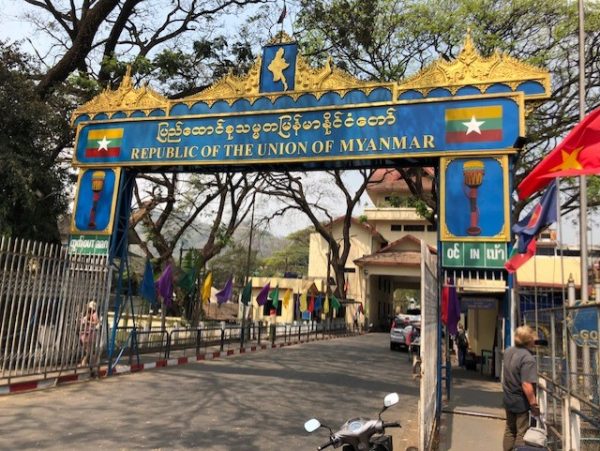
Chiang Rai might have a designated international airport and direct flights from China, Hong Kong, Singapore and Kuala Lumpur, but do travellers see it as a viable gateway to press on and explore Myanmar?
The only Thai province sharing borders with two neighbouring countries, there are opportunities to go further. One option is to take the riverboat along the Mekong River downstream to Luang Prabang in Laos and the other is to head north to Keng Tung in Shan State, Myanmar.
Sure you can spend weeks, months or even years quietly exploring Chiang Rai, a province that carefully hides its attractions to confuse the casual traveller. But for the incurably curious traveller who has “done Chiang Rai in three days”, the question is always “what’s next”? That question might take them to the border with Myanmar to check just what lies beyond the narrow river bridge that separates the border towns of Mae Sai and Tachileik.
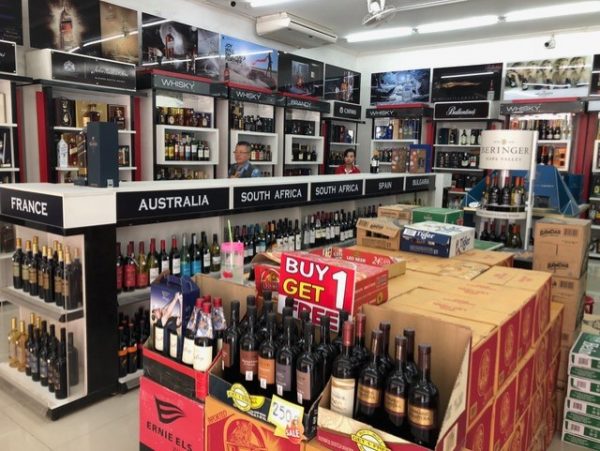
I reckon out of the thousands of international travellers who visit Chiang Rai just a few will peer through the dusty haze that cloaks Tachileik across that narrow bridge and declare “I am going to find out.”
Finding out starts at the relatively new “Downtown” bus station in Chiang Rai town where the smart looking “blue” commuter vans wait for passengers heading for Mae Sai at the border. The vans depart around every 30 minutes, from dawn to dusk, or whenever all 14 seats are occupied at the THB50 one-way fare. It takes one hour to cover the 59 km distance to the small bus station on the outskirts of Mae Sai town where “song taew’ buses transfer passengers to the border (5 km away at the end of the town’s main street) for a fare of just THB15.
You need to turn your clock back 30 minutes after you cross into Myanmar, but the opening hours at the border checkpoints are 0600 to 2100 (Thai time).
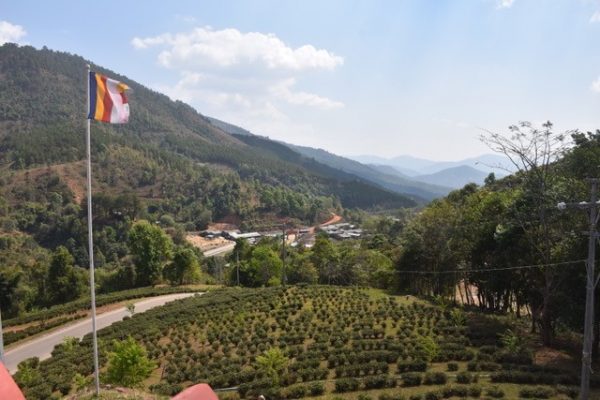
Most visitors cross the border take a stroll around the dusty market and hurry back to Mae Sai. To accomplish that 250-metre sprint you need to deposit your passport and enter Tachileik on a day border pass.
To visit Keng Tung, 160 km north of the border you will need a visa if you are not joining a tour group accompanied by a guide (border pass valid for up to 14 days for trips to Keng Tung only). Nationalities that enjoy visa-free status at Tachileik are Singapore, Korea, Japan, Hong Kong and Macau.
If you are eligible for an eVisa, pay the USD50 fee and enjoy the convenience of an efficient online service. Usually, the approval email arrives the same day as your application. This option allows you to travel to Keng Tung by taxi without having to hire a guide.
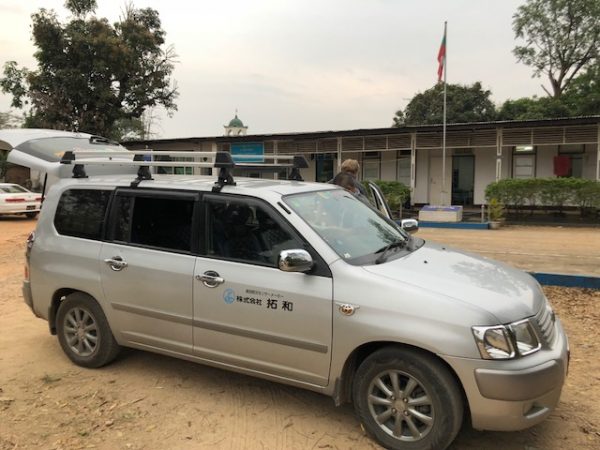
It takes about five minutes to pass through immigration on the Thai side. After you walk across the bridge and switch to the right side pavement you will see Myanmar’s visa office where you hand over your eVisa printout and your passport is stamped. Again it takes around five minutes, but there is an additional checkpoint at the office next-door where the police register your visit.
Technically, you are now home and dry ready to hire a taxi for the three-hour drive to Keng Tung.
Here lies the hitch for independent travellers not using a guide or tour company. You have to find a taxi, a hit and miss challenge with far too many touts ready to take you to the cleaners.
Walk down the street for 100 metres and at the roundabout take stock of the taxi situation. On the left corner of the
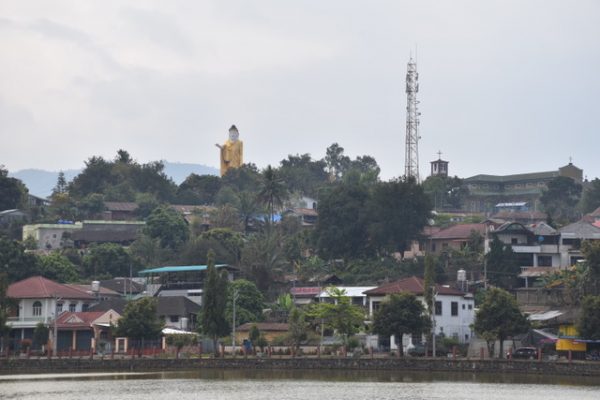
City landmarks: Standing Buddha points to the city and a Catholic cathedral vies for attention.
Taxis will ask for MMK120,000 one-way to Keng Tung, but we managed to get one for MMK60,000 one-way from a driver who lived in Keng Tung. He had bought himself a right-hand drive, second-hand, Toyota Succeed estate car imported from Japan still sporting the original owner’s company
Compared with sitting in a new Toyota ‘blue’ commuter van from Mae Sai to the border the transfer to Keng Tung was definitely a downgrade in service with the potential to present layers of hassles and haggling. Just 100 metres difference in tarmac travelled, but worlds apart in service delivery.
We hadn’t finished with the red tape either. The friendly driver needed to take our passports with the eVisa approval papers back to the immigration to secure permission to drive us to Keng Tung. It took him 45 minutes to do the paperwork, that included 15 photocopies that he would need to deposit with two roadside checkpoints and finally at the immigration office in Keng Tung town after we completed the journey.
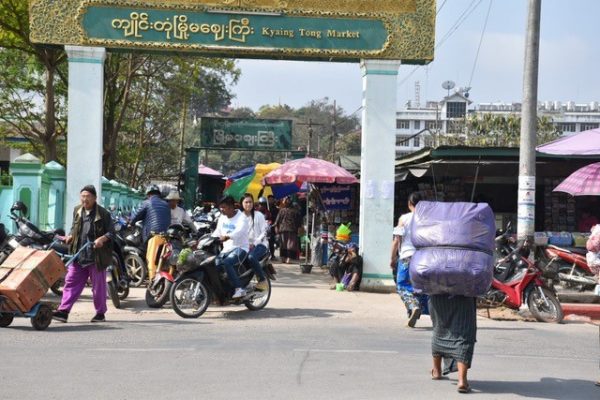
Keng Tung’s central market the town’s top attraction
Counting the original processing with immigration at the border and once again in Keng Tung town, we were checked four times. Obviously, every step of the way our journey was monitored. Has anyone considered GPS tracking, I wondered?
Booking a taxi and picking up tourist information and a map of Keng
As it stands the independent traveller faces numerous pain-points and challenges before they finally set off on the narrow pot-holed highway to Keng Tung.
Officials in Keng Tung did respond to the observations saying “you should have seen it years back, the transfer would have taken all day not three hours and the road wasn’t surfaced.”
Correct indeed. Just a few years ago the road transfer from Tachileik to Keng Tung turned into a dusty daylong marathon passing through around six road checkpoints. Taxis and tour buses raced against the clock to deposit foreign travellers at their hotels by dusk before the mountain road closed for the night.
None of this is relevant today or reassuring for travellers flying to Chiang Rai’s airport on direct flights from Hong Kong, Macau, Singapore and Kuala Lumpur. Travellers who love to explore the region without travel company assistance will discover travel to Keng Tung is hindered by red tape that discourages all but the most determined. Myanmar is the loser and until the national government removes the pain-points, travellers will look at the bridge at Tachileik and take a rain check on a visit to Keng Tung. International travellers by the hundreds are on Myanmar’s doorstep daily but never feel compelled to step beyond the border bridge.






